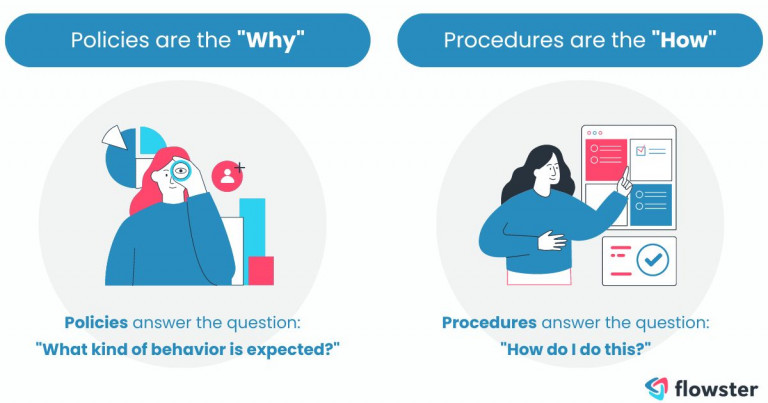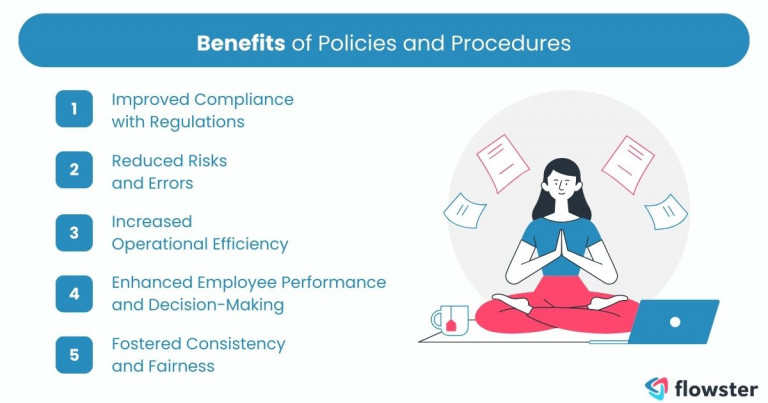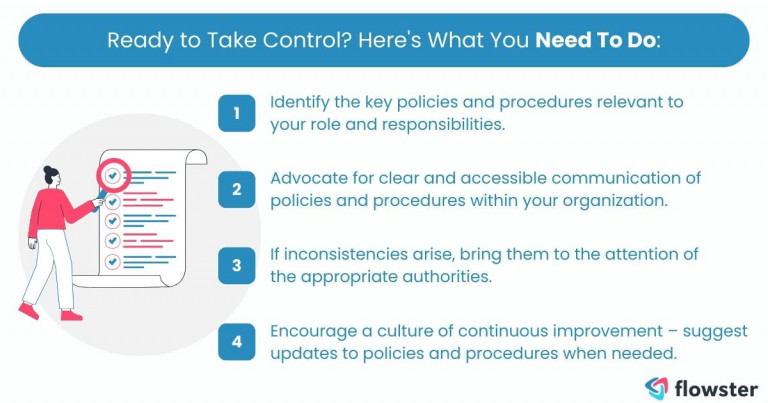Have you ever felt lost in a maze of company policies and procedures? You’re not alone. Imagine this: Sarah, a new marketing intern, needs to submit her first expense report. But where does she even begin? She vaguely remembers an email about expense reimbursement guidelines but can’t find it anywhere. The company handbook mentions a policy, but it’s full of legalese and lacks clear instructions. Frustrated and confused, Sarah doesn’t know who to ask or what steps to take.
This scenario highlights the critical role of clear and well-managed policy and procedure systems in organizations. Just like a well-designed map helps you navigate a maze, effective policies provide direction, and procedures offer step-by-step instructions to get things done efficiently.
This blog post is your guide to conquering the chaos of policies and procedures. We’ll break down the key concepts, explore their responsibilities, and offer tips on identifying and managing them effectively. By the end, you’ll be equipped to navigate your organization’s policies and procedures with confidence, just like a seasoned pro.
Article Outline
What is Policy Management and What Are Some Examples?
Effective organizations don’t run on a whim. They rely on a structured framework that guides decision-making, ensures consistency, and minimizes risks. This framework is established through policy management, the systematic creation, implementation, communication, and maintenance of an organization’s policies and procedures.
Think of policies as the “what” and procedures as the “how” within your organization. Policies set the overall guidelines and expectations for various situations. Procedures, on the other hand, translate those broad principles into clear, step-by-step instructions for employees to follow.
Let’s take a closer look at some real-world examples of policies and procedures across different departments:
Human Resources:
- Code of Conduct: Defines acceptable workplace behavior and outlines consequences for violations.
- Anti-Harassment Policy: Prohibits harassment in all forms and establishes reporting procedures.
- Vacation Policy: Specifies employee eligibility for paid time off and outlines the application process.
Finance:
- Expense Reimbursement Policy: Sets guidelines for allowable business expenses and details the reimbursement process (remember Sarah’s confusion from the introduction?).
- Accounts Payable Procedures: Outlines the step-by-step process for processing and paying vendor invoices.
Information Technology:
- Data Security Policy: Defines measures to protect sensitive information and ensures compliance with data privacy regulations.
- Password Management Procedures: Provides detailed instructions on creating strong passwords and managing them securely.
These are just a few examples, and the specific policies and procedures will vary depending on the nature and size of the organization.
In the next section, we’ll delve deeper into the distinct roles of policies and procedures and how they work together to ensure smooth and efficient operations within your organization.

Understanding the Roles of Policies and Procedures
While both policies and procedures are essential for organizational success, they serve distinct purposes. Let’s break down the key differences:
- Policies are the “why.” They set the broad guidelines, principles, and expectations that govern an organization’s activities. Policies answer questions like “What kind of behavior is expected?” or “What information needs to be protected?” They provide a framework for decision-making and ensure everyone is on the same page regarding overall goals and objectives.
- Procedures are the “how.” They translate policies into clear, step-by-step instructions that guide employees on how to complete specific tasks. Procedures answer the question, “How do I do this?” Imagine a policy as a recipe; it tells you what ingredients you need and the desired outcome (a delicious cake!). But you wouldn’t know how to actually bake the cake without the step-by-step instructions—the procedures—that outline how to mix the ingredients, bake it at the right temperature, and frost it to perfection.
This analogy highlights the complementary nature of policies and procedures. Effective policies provide the foundation, while well-defined procedures ensure consistent and efficient execution.
In the next section, we’ll explore the key responsibilities of well-managed policies and procedures within an organization.

Responsibilities of Policies and Procedures
We’ve established that effective policy and procedure management is the cornerstone of a well-run organization. But what are the real-world benefits? Let’s explore some key responsibilities that well-defined policies and procedures fulfill:
- Improved compliance with regulations: Many industries have specific regulations they must adhere to. Clear policies ensure employees are aware of these regulations and how their work contributes to compliance.
- Reduced risks and errors: Standardized procedures minimize the potential for errors and inconsistencies in task execution. This translates to fewer mistakes, improved quality, and ultimately, reduced risk for the organization.
- Increased operational efficiency: When everyone knows the expected steps for a task, there’s less room for confusion and wasted time. Streamlined procedures lead to greater efficiency and overall productivity.
- Enhanced employee performance and decision-making: Clear guidelines empower employees to make informed decisions within the established framework. Procedures provide a roadmap for completing tasks accurately and efficiently, ultimately boosting employee performance.
- Fostered consistency and fairness: Standardized policies and procedures ensure everyone is treated fairly and plays by the same rules. This promotes a sense of trust and builds a more positive work environment.
In essence, effective policy and procedure management acts as a silent conductor, ensuring all the instruments within an organization play in harmony to achieve the desired results.
Now that we understand the importance of these systems, let’s delve into how to identify and access the policies and procedures relevant to your role within your organization.
Transform Your Business with Flowster's AI-Driven Automation
Identifying Policies and Procedures in Your Organization
Feeling lost in a maze of policies and procedures? Don’t worry, most organizations have designated locations where these documents reside. Here’s your guide to finding the information you need:
- Employee Handbook: This is often the first port of call. A well-organized handbook will compile key policies relevant to all employees, such as a code of conduct, vacation policy, or anti-harassment policy.
- Internal Company Website: Many organizations maintain internal websites or intranets that house a wealth of information, including policy and procedure documents. These websites might be searchable by keyword or categorized by department for easy access.
- Shared Network Drives: Some organizations utilize shared network drives to store various documents, including policies and procedures. Your IT department or manager can guide you on how to access these shared drives.
- Policy Management Software: Forward-thinking organizations are increasingly adopting dedicated policy management software. These platforms offer a centralized location to store, access, and update policies and procedures, ensuring everyone has access to the latest versions.
Knowing where to find policies and procedures is only half the battle. In the next section, we’ll explore what a well-written policy and procedure document should typically contain.

What Should Be Included in a Policy and Procedure?
Now that you know where to find them, let’s delve into the content itself. What should a well-written policy and procedure document typically include?
Crafting Clear Policies:
Effective policies are like well-written instructions—clear, concise, and easy to understand. Here are some key components:
- Clear and concise language: Avoid legalese and jargon. Use plain language that everyone in the organization can comprehend.
- Defined scope and purpose: Clearly outline what the policy covers and its intended purpose. This helps employees understand the situations to which the policy applies.
- Roles and responsibilities: Specify who is responsible for upholding the policy and any departmental or individual roles associated with it.
- Consequences for non-compliance: Outline the potential repercussions of violating the policy. This helps ensure employees take the policy seriously.
- Revision history and version control: Indicate the date of the policy’s creation and any subsequent revisions. This ensures everyone is referring to the most up-to-date version.
Building Effective Procedures:
Procedures translate policies into actionable steps. Here’s what a well-structured procedure document should typically include:
- Step-by-step instructions with clear actions: Break down the task into clear, concise steps that are easy to follow.
- Screenshots or visuals for complex tasks: For intricate procedures, consider including screenshots or visuals to enhance clarity.
- Troubleshooting tips: Anticipate potential roadblocks and provide solutions or troubleshooting steps to guide employees through challenges.
- Contact information for assistance: Specify who employees can contact if they have questions or require further assistance while following the procedure.
By following these guidelines, organizations can ensure their policies and procedures are clear, informative, and user-friendly for all employees.
In the next concluding section, we’ll summarize the key takeaways and emphasize the importance of ongoing management for a truly effective policy and procedure system.

Conquering the Maze: The Power of Effective Policy and Procedure Management
Throughout this blog post, we’ve explored the world of policy and procedure management. We’ve unpacked the key differences between policies (the “why”) and procedures (the “how”) and highlighted the critical role they play in organizational success. We’ve also explored where to find these documents and what makes them well-written and user-friendly.
Remember, clear and well-managed policies and procedures aren’t static documents. The world around us is constantly evolving, and so should your policies and procedures. Regularly review and update your policies to ensure they remain relevant to current regulations, industry best practices, and your organization’s ever-changing needs.
Ready to take control of the maze? Implement a structured approach to policy and procedure management in your organization. By establishing clear guidelines, providing actionable steps, and fostering a culture of ongoing review, you can empower your employees, streamline operations, and ensure your organization thrives in an ever-changing landscape.
Looking for an easy process document writing tool?
Flowster uses AI (artificial intelligence) to make it simple to document your processes, and you can find pre-built workflows and SOP templates in the Flowster Marketplace. These templates are intended to meet a wide range of business needs and can be easily customized to meet your specific requirements.
Are you in need of help? Using our “Done for You” service, our quality and improvement experts will design custom workflows for you. Our team can assist you in developing SOPs from scratch, ensuring that they are completely aligned with your business processes and objectives.





